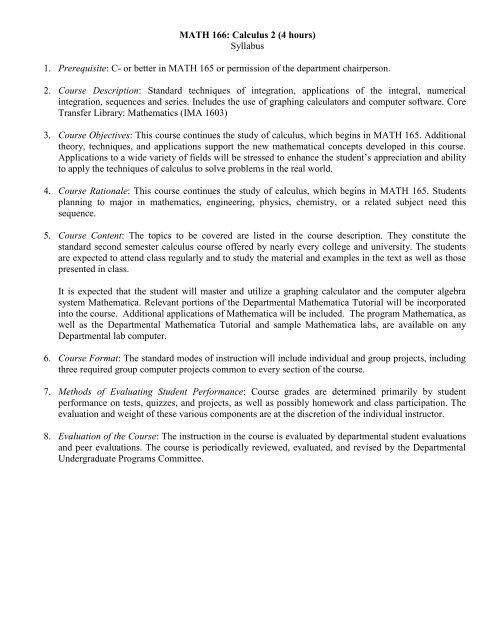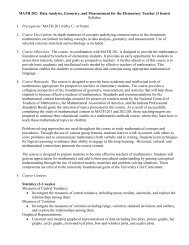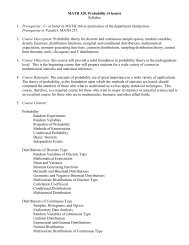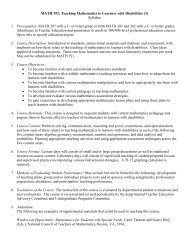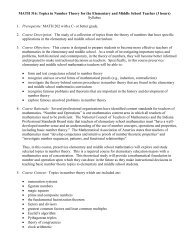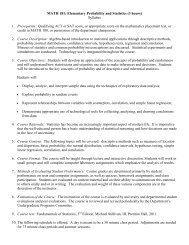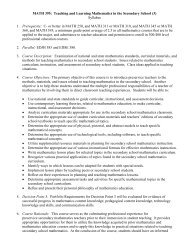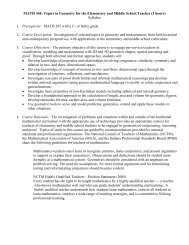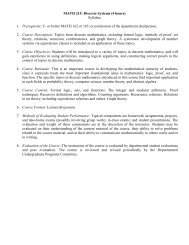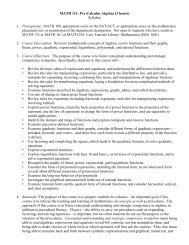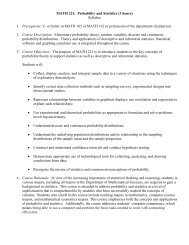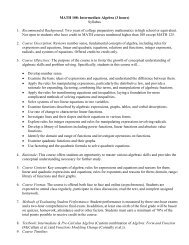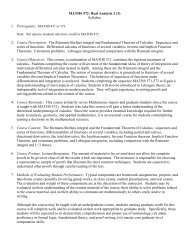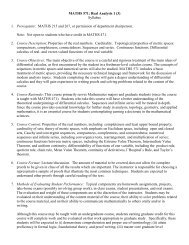MATHS 166: Calculus 2 (4)
MATHS 166: Calculus 2 (4)
MATHS 166: Calculus 2 (4)
Create successful ePaper yourself
Turn your PDF publications into a flip-book with our unique Google optimized e-Paper software.
MATH <strong>166</strong>: <strong>Calculus</strong> 2 (4 hours)<br />
Syllabus<br />
1. Prerequisite: C- or better in MATH 165 or permission of the department chairperson.<br />
2. Course Description: Standard techniques of integration, applications of the integral, numerical<br />
integration, sequences and series. Includes the use of graphing calculators and computer software. Core<br />
Transfer Library: Mathematics (IMA 1603)<br />
3. Course Objectives: This course continues the study of calculus, which begins in MATH 165. Additional<br />
theory, techniques, and applications support the new mathematical concepts developed in this course.<br />
Applications to a wide variety of fields will be stressed to enhance the student’s appreciation and ability<br />
to apply the techniques of calculus to solve problems in the real world.<br />
4. Course Rationale: This course continues the study of calculus, which begins in MATH 165. Students<br />
planning to major in mathematics, engineering, physics, chemistry, or a related subject need this<br />
sequence.<br />
5. Course Content: The topics to be covered are listed in the course description. They constitute the<br />
standard second semester calculus course offered by nearly every college and university. The students<br />
are expected to attend class regularly and to study the material and examples in the text as well as those<br />
presented in class.<br />
It is expected that the student will master and utilize a graphing calculator and the computer algebra<br />
system Mathematica. Relevant portions of the Departmental Mathematica Tutorial will be incorporated<br />
into the course. Additional applications of Mathematica will be included. The program Mathematica, as<br />
well as the Departmental Mathematica Tutorial and sample Mathematica labs, are available on any<br />
Departmental lab computer.<br />
6. Course Format: The standard modes of instruction will include individual and group projects, including<br />
three required group computer projects common to every section of the course.<br />
7. Methods of Evaluating Student Performance: Course grades are determined primarily by student<br />
performance on tests, quizzes, and projects, as well as possibly homework and class participation. The<br />
evaluation and weight of these various components are at the discretion of the individual instructor.<br />
8. Evaluation of the Course: The instruction in the course is evaluated by departmental student evaluations<br />
and peer evaluations. The course is periodically reviewed, evaluated, and revised by the Departmental<br />
Undergraduate Programs Committee.
MATH <strong>166</strong> Learning Objectives<br />
Students will be able to:<br />
1. Compute exact values for integrals using the following techniques of integration:<br />
a. Integration by parts<br />
b. Trigonometric substitution<br />
c. Partial fractions<br />
2. Compute approximate values for integrals using numerical methods, including the<br />
Midpoint Rule, the Trapezoidal Rule, and Simpson’s Rule.<br />
3. Determine error bounds associated with numerical methods such as the Midpoint<br />
Rule, the Trapezoidal Rule, and Simpson’s Rule.<br />
4. Recognize and solve problems involving applications of the definite integral.<br />
Such applications include:<br />
a. Areas between curves<br />
b. Volumes of solids of revolution<br />
c. Surface areas of surfaces of revolution<br />
d. Work<br />
e. Average value of a function<br />
f. Arc length<br />
g. Hydrostatic force<br />
h. Center of mass<br />
i. Probability<br />
5. Compute exact values for improper integrals.<br />
6. Use the Comparison Test to determine whether an improper integral converges.<br />
7. Define the following:<br />
a. Infinite sequence<br />
b. Convergence of an infinite sequence<br />
c. Infinite series<br />
d. Alternating series<br />
e. Convergence of an infinite series<br />
f. Absolute convergence of an infinite series<br />
8. Compute the sum of a geometric series.<br />
9. Determine whether a positive-termed series converges using various tests,<br />
including:<br />
a. Integral Test<br />
b. Comparison Test<br />
10. Determine whether an alternating series converges using the Alternating Series<br />
Test.<br />
11. Determine absolute convergence using:<br />
a. Ratio Test<br />
b. Root Test<br />
12. Compute the radius of convergence and interval of convergence for a power<br />
series.<br />
13. Compute the Taylor series representation of a smooth function.<br />
14. Recognize a MacLaurin series as a special case of a Taylor series.
15. Use Taylor’s Theorem to:<br />
a. Show that the natural exponential function, the trigonometric functions,<br />
and polynomials are real analytic.<br />
b. Approximate functions using polynomials.<br />
16. Recognize and solve separable differential equations.<br />
17. Solve problems involving applications of separable differential equations, such as<br />
population growth.<br />
18. For curves defined by parametric equations, compute:<br />
a. Slopes of tangents<br />
b. Arc length<br />
c. Surface area of surfaces of revolution<br />
d. Volumes of solids of revolution<br />
19. Plot curves in polar coordinates.<br />
20. Convert between polar and rectangular coordinates.<br />
21. For curves defined by polar coordinates, compute:<br />
a. Arc length<br />
b. Area between curves<br />
[Fall 2005, M. Karls; December 2009, Assessment Committee, R. Bremigan, Chair;<br />
December 2008, M. Begum & J. Lorch; Oct 2012, UPC, R. Pierce Chair; Fall 2014,<br />
UPC, R. Pierce, Chair]


